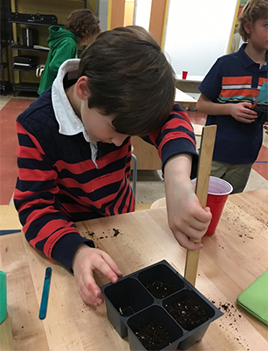Looking at a bucket full of gardening spades shouldn't be exciting, but my second graders at Collegiate School in Richmond, Virginia, couldn't wait to get their hands on those tools!
During our recent visit to the Brock Environmental Center they were eager to plant the coastal panic grass they had spent the winter nurturing. It wasn't just the prospect of getting dirty that they looked forward to. Turning the sandy soil and placing their sprouts was the culmination of a year-long collaboration with the Chesapeake Bay Foundation's wonderful education staff at the Brock Center. Through their experiences at the Brock Center in the fall, and at school this winter, the students knew they were contributing to the health of the Bay by planting their grasses.

Each sprout was met with excitement. Here, Brett measures the panic grass his class grew for transplanting at CBF's Brock Environmental Center.
Samantha Huber.
Each sprout started as a seed in our classroom. The first sprout was met with excited cheering, and believe it or not, each subsequent sprout was a cause for celebration! The students babied their plants. They watered them, rotated the grass trays to ensure even sun exposure, and checked on their growth with a ruler to make sure they were coming along nicely.
I think they were loved a little too much—we lost some of the baby sprouts to overwatering. But this too was a learning experience, and we currently have a set of grass growing in the room based on the recommendations of my little gardeners.
Over the winter during science time, the students experimented with growing lawn grass in the conditions of the bay (sandy soil, brackish water) and created packaging to safely transport the dune grasses back to the Brock Center. We learned about the Chesapeake Bay Watershed, and how important conservation is to the Bay's continued health.
All of this kept their excitement high, and they couldn't wait to get back to the Brock Center this spring to transplant the grasses. We arrived on the first sunny spring day of the year. The sun was sparkling on the bay, periwinkle snails were nestled in the mud, and a large, bare, sandy spot was marked off for our planting.
I know the students felt good about their contribution to the Bay because their smiles and joy spoke volumes. This service learning experience is something they won't soon forget and hopefully helps create life-long conservationists!
Samantha Huber
Issues in this Post
Bay Grasses Education Restoration Volunteers Brock Environmental Center CBF in Virginia



